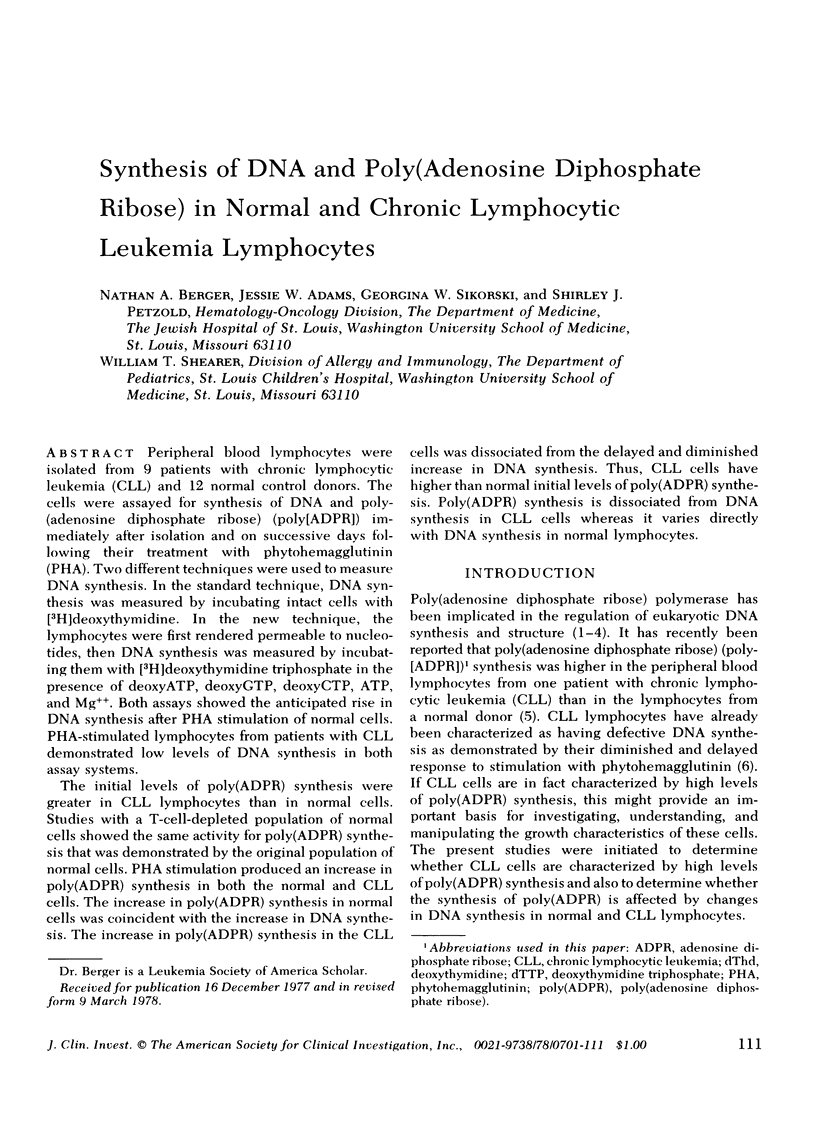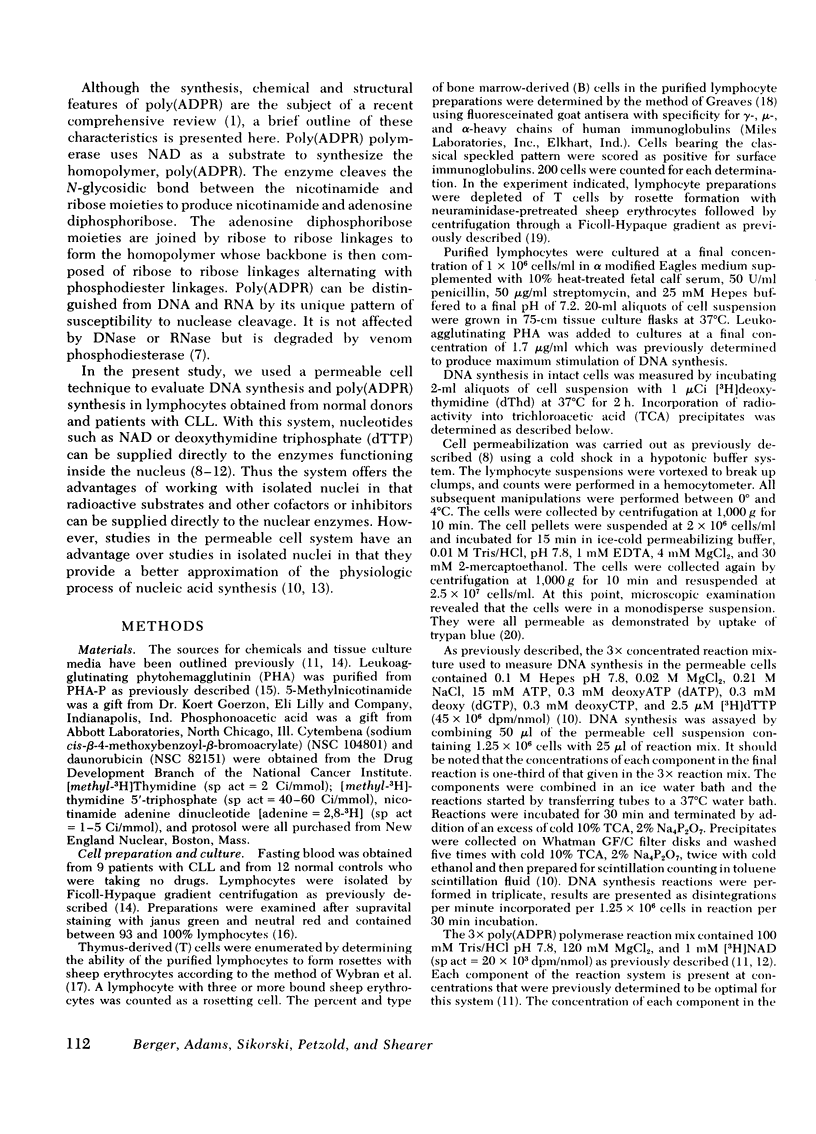Abstract
Peripheral blood lymphocytes were isolated from 9 patients with chronic lymphocytic leukemia (CLL) and 12 normal control donors. The cells were assayed for synthesis of DNA and poly-(adenosine diphosphate ribose) (poly[ADPR]) immediately after isolation and on successive days following their treatment with phytohemagglutinin (PHA). Two different techniques were used to measure DNA synthesis. In the standard technique, DNA synthesis was measured by incubating intact cells with [3H]deoxythymidine. In the new technique, the lymphocytes were first rendered permeable to nucleotides, then DNA synthesis was measured by incubating them with [3H]deoxythymidine triphosphate in the presence of deoxyATP, deoxyGTP, deoxyCTP, ATP, and Mg++. Both assays showed the anticipated rise in DNA synthesis after PHA stimulation of normal cells. PHA-stimulated lymphocytes from patients with CLL demonstrated low levels of DNA synthesis in both assay systems.
The initial levels of poly(ADPR) synthesis were greater in CLL lymphocytes than in normal cells. Studies with a T-cell-depleted population of normal cells showed the same activity for poly(ADPR) synthesis that was demonstrated by the original population of normal cells. PHA stimulation produced an increase in poly(ADPR) synthesis in both the normal and CLL cells. The increase in poly(ADPR) synthesis in normal cells was coincident with the increase in DNA synthesis. The increase in poly(ADPR) synthesis in the CLL cells was dissociated from the delayed and diminished increase in DNA synthesis. Thus, CLL cells have higher than normal initial levels of poly(ADPR) synthesis. Poly(ADPR) synthesis is dissociated from DNA synthesis in CLL cells whereas it varies directly with DNA synthesis in normal lymphocytes.
Full text
PDF







Selected References
These references are in PubMed. This may not be the complete list of references from this article.
- Alberts B., Sternglanz R. Recent excitement in the DNA replication problem. Nature. 1977 Oct 20;269(5630):655–661. doi: 10.1038/269655a0. [DOI] [PubMed] [Google Scholar]
- BOYSE E. A., OLD L. J., CHOUROULINKOV I. CYTOTOXIC TEST FOR DEMONSTRATION OF MOUSE ANTIBODY. Methods Med Res. 1964;10:39–47. [PubMed] [Google Scholar]
- Berger N. A., Johnson E. S. DNA synthesis in permeabilized mouse L cells. Biochim Biophys Acta. 1976 Feb 18;425(1):1–17. doi: 10.1016/0005-2787(76)90211-2. [DOI] [PubMed] [Google Scholar]
- Berger N. A., Petzold S. J., Johnson E. S. High molecular weight DNA intermediates synthesized by permeabilized L cells. Biochim Biophys Acta. 1977 Sep 6;478(1):44–58. doi: 10.1016/0005-2787(77)90242-8. [DOI] [PubMed] [Google Scholar]
- Berger N. A., Weber G. Description of a permeable eukaryotic cell system to study agents affecting DNA synthesis: demonstration that cytembena is a direct inhibitor of replicative DNA synthesis. J Natl Cancer Inst. 1977 Apr;58(4):1167–1169. doi: 10.1093/jnci/58.4.1167. [DOI] [PubMed] [Google Scholar]
- Bhuyan B. K., Scheidt L. G., Fraser T. J. Cell cycle phase specificity of antitumor agents. Cancer Res. 1972 Feb;32(2):398–407. [PubMed] [Google Scholar]
- Brightwell M. D., Leech C. E., O'Farrell M. K., Whish W. J., Shall S. Poly(adenosine diphosphate ribose) polymerase in Physarum polycephalum. Biochem J. 1975 Apr;147(1):119–129. doi: 10.1042/bj1470119. [DOI] [PMC free article] [PubMed] [Google Scholar]
- Brody J. I., Oski F. A., Singer D. E. Impaired pentose phosphate shunt and decreased glycolytic activity in lymphocytes of chronic lymphocytic leukemia. Metabolic pathway. Blood. 1969 Oct;34(4):421–429. [PubMed] [Google Scholar]
- Burzio L., Koide S. S. A functional role of polyADPR in DNA synthesis. Biochem Biophys Res Commun. 1970 Sep 10;40(5):1013–1020. doi: 10.1016/0006-291x(70)90894-6. [DOI] [PubMed] [Google Scholar]
- Burzio L., Reich L., Koide S. S. Poly (adnenosine diphosphoribose) synthase activity of isolated nuclei of normal and leukemic leukocytes. Proc Soc Exp Biol Med. 1975 Sep;149(4):933–938. doi: 10.3181/00379727-149-38930. [DOI] [PubMed] [Google Scholar]
- Davies M. I., Shall S., Skidmore C. J. Poly(adenosine diphosphate ribose) polymerase and deoxyribonucleic acid damage [proceedings]. Biochem Soc Trans. 1977;5(4):949–950. doi: 10.1042/bst0050949. [DOI] [PubMed] [Google Scholar]
- Graham F. L., Whitmore G. F. Studies in mouse L-cells on the incorporation of 1-beta-D-arabinofuranosylcytosine into DNA and on inhibition of DNA polymerase by 1-beta-D-arabinofuranosylcytosine 5'-triphosphate. Cancer Res. 1970 Nov;30(11):2636–2644. [PubMed] [Google Scholar]
- Greaves M. F. Biological effects of anti-immunoglobulins: evidence for immunoglobulin receptors on 'T' and 'B' lymphocytes. Transplant Rev. 1970;5:45–75. doi: 10.1111/j.1600-065x.1970.tb00356.x. [DOI] [PubMed] [Google Scholar]
- Griffiths T. D., Tolmach L. J. Age-dependence of the x-ray-induced deficiency in DNA synthesis in HeLa S3 cells during Generation 1. Radiat Res. 1975 Sep;63(3):501–530. [PubMed] [Google Scholar]
- Havemann K., Rubin A. D. The delayed response of c0ronic lymphocytic leukemia lymphocytes to phytohemagglutinin in vitro. Proc Soc Exp Biol Med. 1968 Mar;127(3):668–671. doi: 10.3181/00379727-127-32769. [DOI] [PubMed] [Google Scholar]
- Hayaishi O., Ueda K. Poly(ADP-ribose) and ADP-ribosylation of proteins. Annu Rev Biochem. 1977;46:95–116. doi: 10.1146/annurev.bi.46.070177.000523. [DOI] [PubMed] [Google Scholar]
- Lehmann A. R., Kirk-Bell S., Shall S., Whish W. J. The relationship between cell growth, macromolecular synthesis and poly ADP-ribose polymerase in lymphoid cells. Exp Cell Res. 1974 Jan;83(1):63–72. doi: 10.1016/0014-4827(74)90688-0. [DOI] [PubMed] [Google Scholar]
- Leinbach S. S., Reno J. M., Lee L. F., Isbell A. F., Boezi J. A. Mechanism of phosphonoacetate inhibition of herpesvirus-induced DNA polymerase. Biochemistry. 1976 Jan 27;15(2):426–430. doi: 10.1021/bi00647a029. [DOI] [PubMed] [Google Scholar]
- Lohrmann H. P., Novikovs L., Graw R. G., Jr Cellular interactions in the proliferative response of human T and B lymphocytes to phytomitogens and allogeneic lymphocytes. J Exp Med. 1974 Jun 1;139(6):1553–1567. doi: 10.1084/jem.139.6.1553. [DOI] [PMC free article] [PubMed] [Google Scholar]
- MAK S., TILL J. E. THE EFFECTS OF X-RAYS ON THE PROGRESS OF L-CELLS THROUGH THE CELL CYCLE. Radiat Res. 1963 Dec;20:600–618. [PubMed] [Google Scholar]
- Makino F., Okada S. Effects of ionizing radiation on DNA replication in cultured mammalian cells. Radiat Res. 1975 Apr;62(1):37–51. [PubMed] [Google Scholar]
- Mendelsohn J., Skinner A., Kornfeld S. The rapid induction by phytohemagglutinin of increased alpha-aminoisobutyric acid uptake by lymphocytes. J Clin Invest. 1971 Apr;50(4):818–826. doi: 10.1172/JCI106553. [DOI] [PMC free article] [PubMed] [Google Scholar]
- Miller E. G. Stimulation of nuclear poly (adenosine diphosphate-ribose) polymerase activity from HeLa cells by endonucleases. Biochim Biophys Acta. 1975 Jun 16;395(2):191–200. doi: 10.1016/0005-2787(75)90158-6. [DOI] [PubMed] [Google Scholar]
- Nishizuka Y., Ueda K., Nakazawa K., Hayaishi O. Studies on the polymer of adenosine diphosphate ribose. I. Enzymic formation from nicotinamide adenine dinuclotide in mammalian nuclei. J Biol Chem. 1967 Jul 10;242(13):3164–3171. [PubMed] [Google Scholar]
- Nishizuka Y., Ueda K., Yoshihara K., Yamamura H., Takeda M., Hayaishi O. Enzymic adenosine diphosphoribosylation of nuclear proteins. Cold Spring Harb Symp Quant Biol. 1969;34:781–786. doi: 10.1101/sqb.1969.034.01.088. [DOI] [PubMed] [Google Scholar]
- Piessens W. F., Schur P. H., Moloney W. C., Churchill W. H. Lymphocyte surface immunoglobulins. Distribution and frequency in lymphoproliferative diseases. N Engl J Med. 1973 Jan 25;288(4):176–180. doi: 10.1056/NEJM197301252880403. [DOI] [PubMed] [Google Scholar]
- Preiss J., Schlaeger R., Hilz H. Specific inhibition of poly adpribose polymerase by thymidine and nicotinamide in HeLa cells. FEBS Lett. 1971 Dec 15;19(3):244–246. doi: 10.1016/0014-5793(71)80524-0. [DOI] [PubMed] [Google Scholar]
- Quagliata F., Faig D., Conklyn M., Silber R. Studies on the lymphocyte 5'-nucleotidase in chronic lymphocytic leukemia, infectious mononucleosis, normal subpopulations, and phytohemagglutinin-stimulated cells. Cancer Res. 1974 Dec;34(12):3197–3202. [PubMed] [Google Scholar]
- Rabinowitz Y., Wong P., Wilhite B. A. Effect of phytohemagglutinin on enzymes of thymidine salvage pathway of cultured chronic lymphatic leukemic lymphocytes. Blood. 1970 Feb;35(2):236–242. [PubMed] [Google Scholar]
- Ramsey R. L., Ultmann J. E. Protein synthesis by ribosomes from blood lymphocytes of normals and patients with chronic lymphocytic leukemia (CLL). Proc Soc Exp Biol Med. 1972 Dec;141(3):839–841. doi: 10.3181/00379727-141-36885. [DOI] [PubMed] [Google Scholar]
- Seki S., Lemahieu M., Mueller G. C. A permeable cell system for studying DNA replication in synchronized HeLa cells. Biochim Biophys Acta. 1975 Feb 10;378(3):333–343. doi: 10.1016/0005-2787(75)90178-1. [DOI] [PubMed] [Google Scholar]
- Silber R., Conklyn M., Grusky G., Zucker-Franklin D. Human lymphocytes: 5'-nucleotidase-positive and -negative subpopulations. J Clin Invest. 1975 Nov;56(5):1324–1327. doi: 10.1172/JCI108209. [DOI] [PMC free article] [PubMed] [Google Scholar]
- Tseng B. Y., Goulian M. DNA synthesis in human lymphocyts: intermediates in DNA synthesis, in vitro and in vivo. J Mol Biol. 1975 Dec 5;99(2):317–337. doi: 10.1016/s0022-2836(75)80149-5. [DOI] [PubMed] [Google Scholar]
- Tung R., Silber R., Quagliata F., Conklyn M., Gottesman J., Hirschhorn R. Adenosine deaminase activity in chronic lymphocytic leukemia. Relationship to B- and T-cell subpopulations. J Clin Invest. 1976 Mar;57(3):756–761. doi: 10.1172/JCI108334. [DOI] [PMC free article] [PubMed] [Google Scholar]
- Wybran J., Carr M. C., Fudenberg H. H. The human rosette-forming cell as a marker of a population of thymus-derived cells. J Clin Invest. 1972 Oct;51(10):2537–2543. doi: 10.1172/JCI107069. [DOI] [PMC free article] [PubMed] [Google Scholar]


